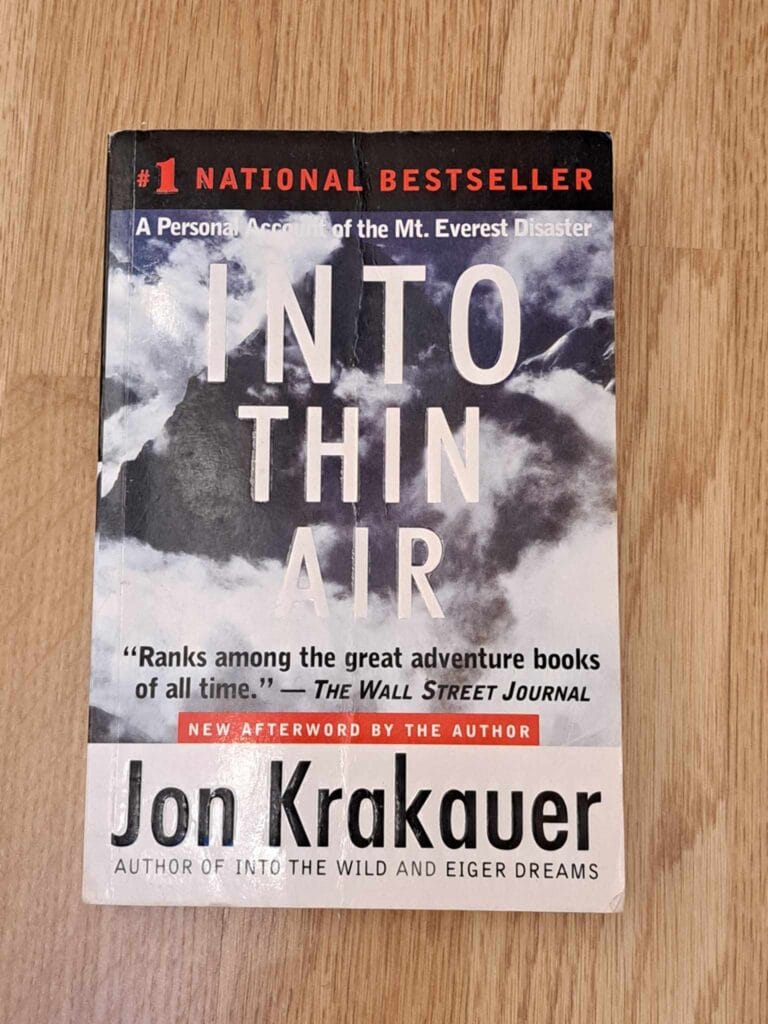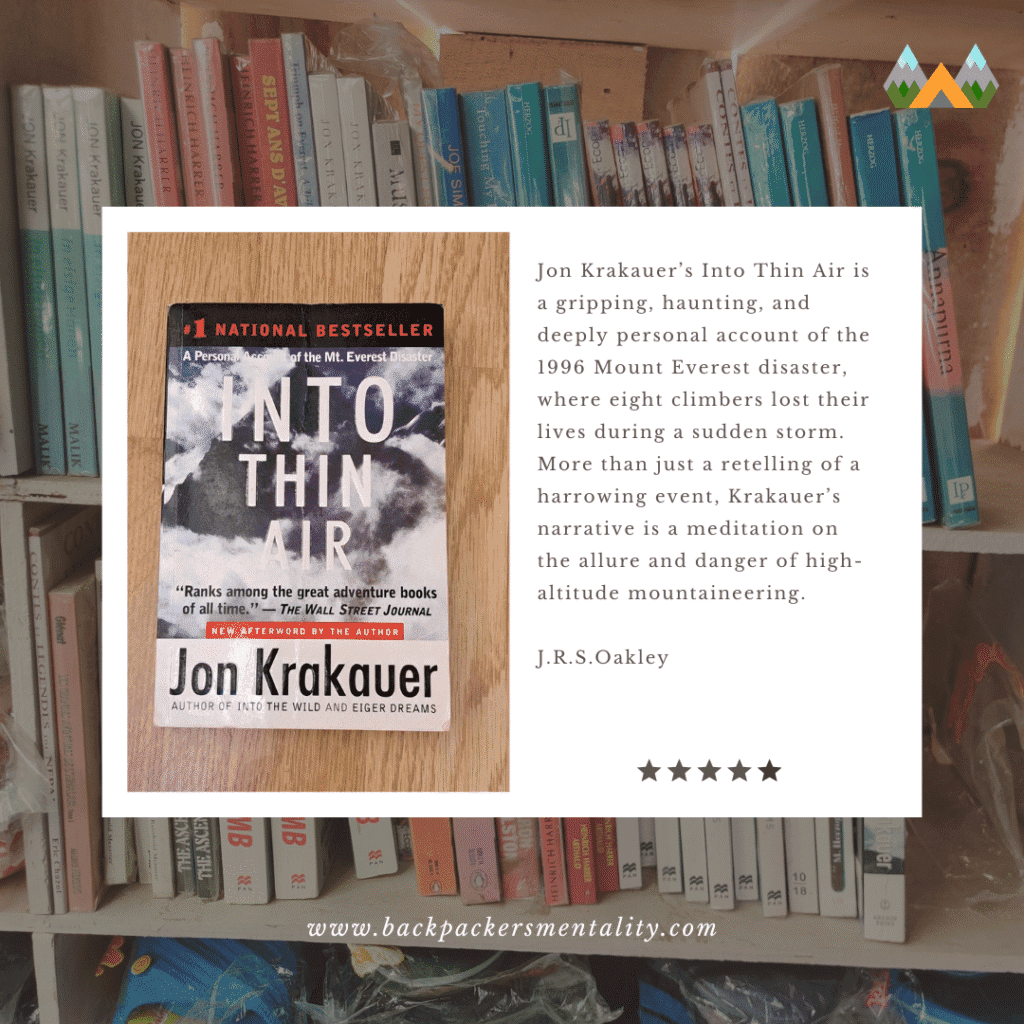Book Review: Into Thin Air: A Personal Account of the Mt. Everest Disaster by Jon Krakauer
Overview
Jon Krakauer’s Into Thin Air is a non-fiction best selling story about climbing and tragedy on Mount Everest. Set in 1996, this is a gripping, haunting, and deeply personal account of the 1996 Mount Everest disaster. Eight climbers lost their lives during a sudden storm and rescuing the others was a life threatening challenge. The stories told have led to controversy from different survivor accounts. More than just a retelling of a harrowing event, Krakauer’s narrative is a exposé on the allure and danger of high-altitude mountaineering.

Summary
Background
Originally sent to Everest on assignment for Outside magazine, Krakauer was both a journalist and a mountaineering climber. He had joined up with the famous mountain guide Rob Hall on an expedition in 1996 to report up to Base Camp. But the pull of potentially summiting Everest and achieving a childhood dream was too much to pass up. His first-hand perspective gives the book an immediacy and urgency that few adventure books can match. The fast paced narrative combines drama and technical writing seamlessly. It blends personal reflection of the different parties and covers the rivalry between Rob Hall and Scott Fischer. Krakauer also provides details of historical context about early Everest discovery and naming. As well as the attempts by Mallory in the 1920s and the world breaking first summit by Hillary & Tenzing. The book explains the science of extreme altitude and safety techniques needed for safe passage too.
The Story
What unfolded was human competition that pushed these limits and risked the lives of all the climbers on Everest. Krakauer explains how lack of sleep and oxygen began to cloud clear thinking just as the clouds welcomed in a storm. After surviving the decent in thick clouds, snow blizzards and freezing temperatures, he collapsed from exhaustion. The next morning, the aftermath of the disaster became apparent. The vastly experienced and respected guides Rob Hall (New Zealander) and Scott Fischer (American) didn’t survive the storm that struck in May 1996. Even the best reputations, equipment and skill might not be enough to save you above 8000 metres in the death zone.
What makes Into Thin Air stand out is Krakauer’s honesty and self-recrimination. He doesn’t shy away from his own role or mistakes, and he wrestles openly with survivor’s guilt. His prose is clear and powerful, along with his portraits of the climbers—both those who lived and those who perished—are respectful and haunting. The book also raises larger questions about the commercialization of Everest, the limits of human endurance, and the price of ambition. Though some of Krakauer’s accounts have been challenged by other survivors, Into Thin Air remains a compelling and sobering read.
Strengths:
- Emotional depth: Krakauer’s vulnerability and self-awareness add a powerful layer to the story. It makes it more than just an action or dramatic story.
- Clear, vivid prose: His writing is crisp, descriptive, and engaging. Into Thin Air is a real page turner and brings the harsh beauty and dangers of Everest to life.
- Well-researched context: The book provides background on mountaineering history, high-altitude physiology, and the growing commercialization of Everest. Overall, it provides readers with a fuller understanding of the situation.
Weaknesses:
- Subjectivity: While Krakauer’s personal lens makes the book compelling, it also introduces bias. Other survivor’s have contested his version of events to complicate the story.
- Limited perspectives: The book centers heavily on Krakauer’s experience, sometimes at the expense of broader viewpoints from other climbers or expedition teams. There are multiple other books about the Everest 1996 climbing season with ‘Ultimate High: My Everest Odyssey’ by Goran Kropp giving another perspective from Base Camp and his takes on the events.
- Emotional weight: For some readers, the graphic depictions of suffering and death might be overwhelming or difficult to process.
- Controversy: The role of Fischer’s climbing guide, Anatoli Boukreev, on the descent has been dispute by his own book ‘The Climb’ despite Krakauer appreciating his heroic rescue attempts. Other climbers have questioned some of the finer details which Krakauer has responded too.

3 Key Lessons from Into Thin Air:
- Nature is indifferent to human ambition: No amount of planning or experience can eliminate the risks of extreme environments. Everest, as Krakauer shows, is not conquered—it merely allows passage, temporarily. There is an awareness of the vulnerability of crossing the Khumbu Ice Fields, camping at high altitude and the risk from the lack of Oxygen. The Death Zone is famous for being inhospitable for humans.
- The importance of leadership and decision-making: Small misjudgements at high altitude can have fatal consequences. The book underscores how critical clear thinking, communication, and hierarchy are in survival scenarios. Despite the resilience and determination shown, the timing errors were highlighted and summiting after 2pm significantly increased the dangers.
- The limits of human endurance and ego: Into Thin Air shows that even elite climbers are vulnerable. Pushing beyond physical or mental limits for the sake of achievement can come at a devastating cost. The role of Sherpas in enabling these attempts were considered but not focused on compared to other Himalayan adventure books.
Conclusion
A stunning and sobering tale of adventure gone wrong. Into Thin Air is a must-read for anyone fascinated by human resilience, extreme environments, or the price of pushing beyond the edge. It’s beyond just a survival story. It’s a morality reminder of the fragile line between triumph and tragedy when mountaineering.
Rating Into Thin Air
BM Rating: ⭐️⭐️⭐️⭐️⭐️ (5.0/5)
Goodreads Rating: 4.25 / 5 (541,549 Ratings)
Find more Book Reviews and Recommendations on The Bookshelf as well as other useful travel tips.
What is your favourite mountaineering book? I’m always looking to build my book collection.
Pingback: What Makes Chris Bonington: Ascent a Must-Read? - Backpacker's Mentality
Pingback: Ultimate High Book Review: Odyssey of Goran Kropp - Backpacker's Mentality